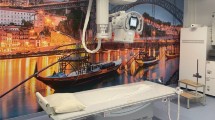Abstract
Purpose
The aim of this study was to test the potential application of a new nonmagnetic device capable of diagnostically evaluating stress of the knee joint during magnetic resonance imaging (MRI) investigation.
Materials and methods
The Knee Loader® prototype was applied to an MRI scanner with a 1.5-T superconducting magnet. Twenty healthy subjects were assessed in both baseline conditions and again after applying a known amount of force (in kg) to various joints. Standard MR techniques were employed. The degree of anterior and posterior tibial translation and variations in the width of the rim in varus and valgus were measured in millimetres.
Results
In 12 cases, the anterior drawer test demonstrated a rest-stress variation between 0 and 2 mm, and in two cases, the posterior drawer test was between 1 and 3 mm. In the four cases assessed at valgus angulations and the two cases assessed at varus angulations, the opening of medial and lateral compartment was between 1 and 2 mm.
Conclusions
The preliminary data regarding this new MR method, performed using the Knee Loader® prototype, demonstrate that it is possible to obtain functional images of the knee comparable with those obtained by traditional radiological techniques. Its potential advantage lies in the fact that, given the absence of ionising radiation, the investigation can be repeated as necessary, ensuring anatomical visualisation of all joint components under stress.
Riassunto
Obiettivo
Lo scopo del nostro lavoro è quello di verificare l’applicabilità di un nuovo apparecchio amagnetico in grado di effettuare esami diagnostici in condizioni di stress articolare in risonanza magnetica.
Materiali e metodi
È stato applicato il prototipo Knee Loader® ad una apparecchiatura di RM con magnete superconduttivo da 1,5 T. Sono stati eseguiti 20 esami RM in volontari sani, in condizioni di base e con l’impiego di una forza di entità nota (in kg) sui diversi compartimenti articolari. Sono state impiegate tecniche RM standard. Sono stati misurati l’entità in millimetri della traslazione tibiale anteriore e posteriore e gli angoli di varo-valgo.
Risultati
In 12 casi il test del cassetto anteriore ha mostrato una variazione tra 0 mm e 2 mm; in 2 casi il test del cassetto posteriore è risultato essere compreso tra 1 mm e 3 mm. In 4 casi in valgo stress ed in 2 casi in varo stress l’apertura del compartimento mediale e laterale è stata di 1 mm e 2 mm.
Conclusioni
La nuova metodica consente di ottenere immagini funzionali del ginocchio in modo analogo a quanto possibile con radiologia tradizionale. I potenziali vantaggi rispetto alle radiografie tradizionali di ginocchio sono sostanzialmente quelli della RM e della visualizzazione di tutte le componenti endoarticolari sottostress. Saranno necessari ulteriori studi per essere in grado di correlare dati anatomici, patologici e funzionali delle strutture capsulo-legamentose di ginocchio, utilizzando il prototipo Knee Loader® in studio.
Similar content being viewed by others
References/Bibliografia
Singerman R, Berilla J, Kotzar J, Davy DT (1994) A six degree-of-freedom transducer for in vitro measurement of patellofemoral contact forces. J Biomech 27:233–238
Lafortune MA, Cavanagh PR, SommerIII HJ, Kalenak A (1992) Three-dimensional kinematics of the human knee during walking. J Biomech 25:347–357
Rosenberg A, Mikosz RP, Mohler CG (2005) Basic knee biomechanics. In: Scott N (ed) The knee. Mosby, St. Louis, pp 75–94
Dennis DA, Mahfouz MR, Komistek RD, Hoff W (2005) In vivo determination of normal and anterior cruciate ligament-deficient knee kinematcs. J Biomech 38:241–253
Patel VV, Hall K, Ries M et al (2004) A three-dimensional MRI analysis of knee kinematics. J Orth Res 22:283–292
Ramsey DK, Wretemberg PF (1999) Biomechanics od the knee: methodological considerations in the vivo kinematic analysis of the tibiofemoral and patellofemoral joint. Clin Biomech 14:595–611
Jung TM, Reinhardt C, Scheffler SU, Weiler A (2006) Stress radiography to measure posterior cruciate ligament insufficiency: a comparison of five different techniques. Knee Surg Sports Traumatol Atrhosc 14:1116–1121
Schulz MS, Russe K, Lampakis G, Strobel MJ (2005) Reliability of stress radiography for evaluation of posterior knee laxity. Am J Sports Med 33:502–506
Staubli HU, Jakob RPb (1990) Posterior instability of the knee near extension. A clinical and stress radiographic analysis of acute injuries of the posterior cruciate ligament. J Bone Joint Surg Br 72:225–230
Staubli HU, Noesberger B, Jacob RP (1992) Stress radiography of the knee. Cruciate ligament function studied in 138 patients. Acta Orthop Scand Supp 249:1–27
Chassaing V, Deltour F, Touzard R et al (1995) Etude radiologique du L.C.P. à 90° de flexion. Rev Chir Orthop 81:35–38
Freeman MAR, Pinskerova V (2003) The movement of the knee studied by magnetic resonance imaging. Clin Orthop Rel Res 410:35–43
Hill PF, Vedi V, Iwaki H et al (2000) Tibiofemoral movement 2: the loaded and unloaded linving knee studied by MRI. J Bone Joint Surg 82B:1196–1198
Iwaki H, Pinskerova V, Freeman MAR (2000) tibiofemoral movement 1: the shapes and relative movements of the femur and tibia in the unloaded cadaver knee: studied by dissection and MRI. J Bone Joint Surg 82B:1189–1195
Bercovy M, Weber E (1995) Evaluation of laxity, rigidity and compliance of the normal and pathological knee. Application to survival curves of ligamentoplasties. Rev Orthop Reparatrice App Mot 81:114–127
Jacobsen K (1976) Stress radiographical measurement of the antero-posterior, medial and lateral stability of the knee joint. Acta Orthop Scand 47:335–344
Toblas MJ, Carsten R, Sven US, Andreas W (2006) Stress radiography to measure posterior cruciate ligament insufficiency: a comparison of five different techniques. Knee Surg Sports Traumatol Arthrosc 14:1116–1121
Margheritini F, Mancini L, Mauro CS, Mariani PP (2003) Stress radiography for quantify posterior cruciate ligament deficiency. Arthroscopy 19:706–711
Lerat JL, Moyen BL, Cladière F et al (2000) Kee instability after injury to the anterior cruciate ligament. Quantification of the Lachman test. J Bone Joint Surg Br 82:42–47
Author information
Authors and Affiliations
Corresponding author
Rights and permissions
About this article
Cite this article
Bellelli, A., Mancini, P., Artico, M. et al. Technical note: MRI device for active stress of the knee. The practical approach and preliminary data. Radiol med 113, 905–914 (2008). https://doi.org/10.1007/s11547-008-0305-2
Received:
Accepted:
Published:
Issue Date:
DOI: https://doi.org/10.1007/s11547-008-0305-2




